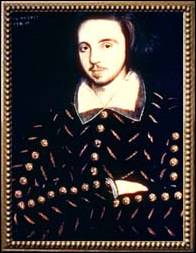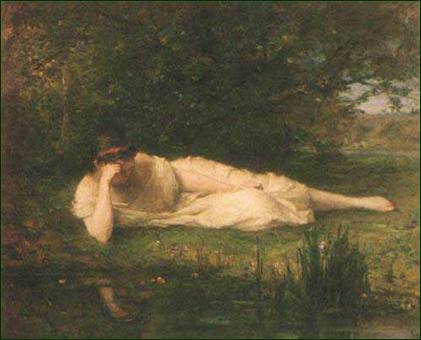THE POETRY OF CHRISTOPHER MARLOWE
AND SIR WALTER RALEIGH


Christopher Marlowe Sir Walter Raliegh
In this unit
you will be reading poetry from the Renaissance Period. The Renaissance is the
movement in which the leaders of thought portrayed the “complete” man - a man
who is both courtly and earned. In addition there was a desire to recover and
imitate the best of classical Greek and Roman writing. A new emphasis was
placed on the importance of the individual.
The first
literary work from that period you will be reading is the poem, “The Passionate
Shepherd to His Love,” by Christopher Marlowe. This poem is a pastoral
poem, a poem that expresses peace and the simplicity of life.
Before you read there are some vocabulary words to define.
Now let’s read
the poem.

|
The Passionate Shepherd to His Love Come live with me and be my Love, And we will sit upon the rocks And I will make thee beds of roses A gown made of the finest wool, A belt of straw and ivy buds Thy silver dishes for thy meat The shepherd swains shall dance and sing Christopher Marlowe (1564-1593) |
See the following website for additional information about Christopher Marlowe: http://www.luminarium.org/renlit/marlowe.htm
Setting
Christopher Marlowe sets the poem in early spring in a rural locale (presumably in England) where shepherds tend their flocks. The use of the word madrigals (Line 8)–referring to poems set to music and sung by two to six voices with a single melody or interweaving melodies–suggests that the time is the 16th Century, when madrigals were highly popular in England and elsewhere in Europe. However, the poem could be about any shepherd of any age in any country, for such is the universality of its theme.
Characters
The
Passionate Shepherd: He importunes a woman–presumably a young and pretty
country girl–to become his sweetheart and enjoy with him all the pleasures that
nature has to offer.
The Shepherd’s Love: The young woman who receives the Passionate
Shepherd’s message.
Swains: Young country fellows whom the Passionate Shepherd promises will
dance for his love.
“The Passionate Shepherd” is a pastoral poem. Pastoral poems generally
center on the love of a shepherd for a maiden (as in Marlowe’s poem), on the
death of a friend, or on the quiet simplicity of rural life. The writer of a
pastoral poem may be an educated city dweller, like Marlowe, who extolls the
virtues of a shepherd girl or longs for the peace and quiet of the country. Pastoral
is derived from the Latin word pastor, meaning shepherd.
The theme of “The Passionate Shepherd” is the rapture of springtime love in
a simple, rural setting. Implicit in this theme is the motif of carpe diem–Latin
for “seize the day.” Carpe diem urges people to enjoy the moment without
worrying about the future.
Writing and Publication Information
Marlowe wrote the poem in 1588 or 1589 while attending Cambridge University
at its Corpus Christi College. It first appeared in print in poetry collections
published in 1599 and 1600.
In each stanza, the first line rhymes with the second, and the third rhymes
with the fourth. The meter is iambic tetrameter,
with eight syllables (four iambic feet) per line. (An iambic foot consists of
an unstressed syllable followed by a stressed syllable.) The following graphic
presentation illustrates the rhyme scheme and meter of Stanza 1:
Come LIVE.|.with ME.|.and BE.|.my LOVE,
And WE.|.will
ALL.|.the
PLEA.|.sures
PROVE
That HILLS.|.and
VALL.|.eys,
DALE.|.and
FIELD,
And ALL.|.the
CRAG.|.gy
MOUNT.|.ains
YIELD.
Over
the centuries, Marlowe’s little poem has enjoyed widespread popularity because
it captures the joy of simple, uncomplicated love. The shepherd does not worry
whether his status makes him acceptable to the girl; nor does he appear
concerned about money or education. The future will take carry of itself. What
matters is the moment. So, he says, let us enjoy it–sitting on a rock listening
to the birds.
The poem by
Marlowe caused other authors to write responses. One of these responses
entitled “The Nymph’s Reply to the Shepherd” was written by Sir Walter Raleigh.
Let’s read the
reply.
|
The Nymph’s Reply to the Shepherd
If all the world and love were young, But Time drives flocks from field to fold; The flowers do fade, and wanton fields Thy gowns, thy shoes, thy beds of roses, Thy belt of straw and ivy-buds, But could youth last, and love still breed, Sir Walter Raleigh (1552?-1618) |
|
The complete title to this poem is “The Nymph's Reply to the Shepherd.”
A look at the two poems side by side:
|
The Passionate
Shepherd to His Love Come
live with me and be my love, And
we will sit upon the rocks, And
I will make thee beds of roses A
gown made of the finest wool A
belt of straw and ivy buds, The
shepherds' swains shall dance and sing |
The Nymph's
Reply to the Shepherd If
all the world and love were young, Time
drives the flocks from field to fold, The
flowers do fade, and wanton fields Thy
gowns, thy shoes, thy bed of roses, Thy
belt of straw and ivy buds, But
could youth last and love still breed, |
![]() Now
answer questions 1 - 10
Now
answer questions 1 - 10